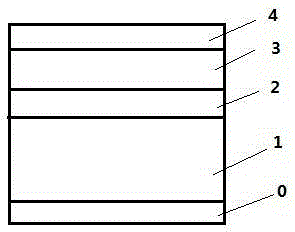Photocatalyst flame-retardant antibacterial floor and production process thereof
A production process and photocatalyst technology, applied in the direction of manufacturing tools, wood processing appliances, construction, etc., can solve the problems of the floor structure and its performance to be improved, and achieve the effect of good insect control, prolonging the storage period and preventing the bonding strength.
- Summary
- Abstract
- Description
- Claims
- Application Information
AI Technical Summary
Problems solved by technology
Method used
Image
Examples
Embodiment 1
[0071] Biomass soybean gum preparation: Add 3g of alkali and 100g of water into a three-necked round bottom flask, the alkali is sodium hydroxide, stir for 3 minutes to dissolve the sodium hydroxide, and then add 0.5g silicate, 0.5 g sulfite and 0.2g modifier, the silicate is sodium silicate, the modifier is urea, and the sulfite is sodium sulfite, and stirred for 3 minutes at a temperature of 80-96 °C to obtain a preliminary mixed solution; then add 15 g of soybean derivative, which is soybean protein isolate, to the preliminary mixed solution, stir for 10 minutes at a temperature of 80°C, so that the soybean protein isolate is fully dispersed in the solution, Obtain a mixed solution; then add 0.3g of the curing agent polyamide polyamine-epichlorohydrin (PAE) aqueous solution with a mass concentration of 12.5% and stir for 10 minutes to obtain a solidified mixed solution; then add the acid, the acid is 0.1 Phosphoric acid with a mass concentration of 35%, stirred for 5 minut...
Embodiment 2
[0099] Biomass soy gum preparation: Add 8g alkali and 100g water into a three-necked round bottom flask. The alkali is sodium hydroxide. Stir for 10 minutes to dissolve the sodium hydroxide. Then add 3g silicate and 3g sulfite to the lye And 5g modifier, the silicate is sodium silicate, the modifier is urea, and the sulfite is sodium sulfite, and stirred for 10 minutes at a temperature of 96°C to obtain a preliminary mixed solution; then add to the preliminary mixed solution Add 40g of soy derivative, which is soy protein isolate, stir for 60 minutes at 96℃, so that the soy protein isolate is fully dispersed in the solution to obtain a mixed solution; then add 2.5g of curing agent with a mass concentration of 12.5% Aqueous solution of polyamide polyamine-epichlorohydrin (PAE) was stirred for 60 minutes to obtain a solidified mixture; then acid was added. The acid was 4g of phosphoric acid with a mass concentration of 35% and stirred for 10 minutes to obtain a pH value of 8. Adj...
Embodiment 3
[0127] Biomass soy gum preparation: Add 5g alkali and 100g water into a three-necked round bottom flask, the alkali is sodium hydroxide, stir for 6 minutes to dissolve the sodium hydroxide, and then add 2g silicate and 2g sulfite to the lye And 2g modifier, silicate is sodium silicate, modifier is urea, sulfite is sodium sulfite, and stirred for 6 minutes at a temperature of 90°C to obtain a preliminary mixed solution; then add to the preliminary mixed solution Add 25g of soy derivative, the soy derivative is soy protein isolate, stir for 30 minutes at a temperature of 90°C, so that the soy protein isolate is fully dispersed in the solution to obtain a mixed solution; then add 3g of a curing agent with a mass concentration of 12.5% Amide polyamine-epichlorohydrin (PAE) aqueous solution, stir for 30 minutes to obtain a solidified mixture; then add acid, acid is 2g of phosphoric acid with a mass concentration of 35%, and stir for 7 minutes to obtain a pH adjustment of 7 Liquid; T...
PUM
 Login to View More
Login to View More Abstract
Description
Claims
Application Information
 Login to View More
Login to View More - R&D
- Intellectual Property
- Life Sciences
- Materials
- Tech Scout
- Unparalleled Data Quality
- Higher Quality Content
- 60% Fewer Hallucinations
Browse by: Latest US Patents, China's latest patents, Technical Efficacy Thesaurus, Application Domain, Technology Topic, Popular Technical Reports.
© 2025 PatSnap. All rights reserved.Legal|Privacy policy|Modern Slavery Act Transparency Statement|Sitemap|About US| Contact US: help@patsnap.com


